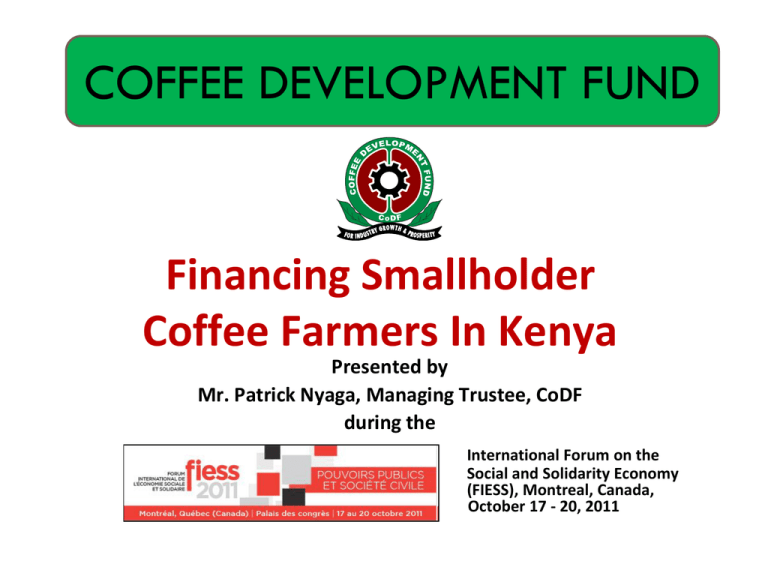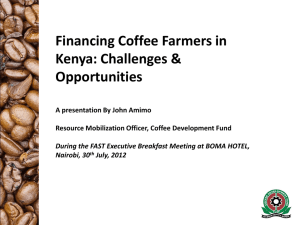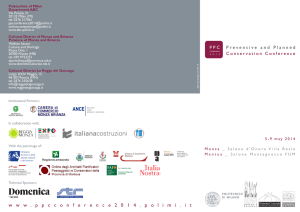Financing The Coffee Sub-Sector In Kenya
advertisement

COFFEE DEVELOPMENT FUND Financing Smallholder Coffee Farmers In Kenya Presented by Mr. Patrick Nyaga, Managing Trustee, CoDF during the International Forum on the Social and Solidarity Economy (FIESS), Montreal, Canada, October 17 - 20, 2011 Kenya’s Coffee Sector Profile • Coffee is one of the most important cash crops in Kenya generating annual revenues of up to $ USD 100 Million. • It is estimated that 6 million Kenyans are employed directly or indirectly in the coffee industry. • The total production potential is 130,000 MT per annum. This is in comparison to current production levels of 50,000 MT. • Although Kenya coffee global market share is small; at 1%, the quality of coffee is highly rated in the world market thus highly demanded by Roasters who mainly use it for blending other coffee varieties. •The total area under coffee is estimated at 160,000 hectares. •Two thirds of all cultivation (113,333 hectares) is handled by low yield, resource poor smallholder farmers with an average yield rate ranging from 0.2 – 0.7 tons/ha. Illustration of National Coffee Production: Coffee Estate Farmers Versus Smallholder Coffee Producers 40% Approximately 3,000 large, small/medium private estate farmers The smallholders produce 40% of the crop while Estate plantations produce the remaining 60%. Approximately 600,000 smallholders organized in cooperative societies 60% Source: Coffee Board of Kenya, Ministry of Agriculture (2009) BACKGROUND • Coffee Development Fund is a state corporation under the Ministry of Agriculture in Kenya. • The Fund was officially established by the Government in May 2006 as a financing vehicle for revitalizing the coffee sub-sector after years of low production trends. • CoDF’s mandate is to provide sustainable, affordable credit and advances to coffee farmers for farm inputs, farming operations and income stabilisation. • Bulk of farmers receiving loans are smallholders organized in cooperatives COFFEE DEVELOPMENT FUND-FACT SHEET BUSINESS FINANCING COFFEE FARMERS CLIENTS SMALL HOLDER FARMERS/ESTATE FARMERS/COOPERATIVE SOCIETIES SERVICES/ MANDATE PROVIDING ACCESSIBLE, AFFORDABLE CREDIT AND FINANCIAL SOLUTIONS TO THE COFFEE SECTOR FUND SIZE $USD 13 MILLION IMPACT 61,245 COFFEE FARMERS ELIGIBILITY COFFEE FARMERS WITH A PRODUCTION RANGE BETWEEN 0.5 - 3 KG OF CHERRY/TREE CURRENT FUNDING STATUS •Public financing through Coffee Development Fund largely remain the main source of coffee financing. •The sub sector is less attractive to private investors due to long turnover periods and a client base considered ‘high risk’ •Only one commercial bank provides targeted financing to coffee farmers. •The sub-sector is need of approximately US $ 125 Million to meet its credit demand. FINANCING APPROACH Value chain Financing approach FARMER (Production) FACTORY/ SOCIETY (Primary Processing) MILLER (Secondary Processing) MARKETING AGENT (Marketing) Financial Requirements Financial Requirements Financial Requirements Financial Requirements *Credit for farm inputs and farming operations. *Credit for farm establishment. *Cherry Advances. *Factory Rehabilitation *Factory Operations *Asset Finance – purchase of machinery Asset finance-Upgrading or purchase of new milling stations. Working Capital Pre-export financing. Financing entry to certification Programmes e.g. Fairtrade, UTZ Kapeh FLOW OF CREDIT VALUE CHAIN FINANCING IN COFFEE • • • Different value chain segments require different types of financing. Smallholders populate the lower end of the value chain segment (Production). in Kenya. The production segment attracts the greatest credit need. Currently the Coffee Development Fund directs most of its credit towards this segment. FINANCING CHALLENGES & INTERVENTIONS Financing Challenges Interventions Undertaken Dispersed and remote location of coffee farmers presents a challenge in credit delivery. Formation of lending partnerships with 26 rural-based financial institutions. Lack of adequate collateral. Adopt social collateral (group lending) to make credit easily accessible to deserving coffee farmers. High cost of production due to high cost of inputs The Fund continues to facilitate bulk acquisition of inputs among cooperatives to minimize costs of production to growers. Governance issues among cooperatives Work closely with other sector players to build capacity for improved governance of cooperatives. FINANCING CHALLENGES & INTERVENTIONS Financing Challenges Interventions Undertaken Unpredictable weather patterns affecting coffee production, leads to losses in potential revenue which is likely to affect loan repayments. Develop appropriate weather risk management tools such as crop insurance to cushion smallholders against unpredictable weather patterns. Lack of a social support system which in the past encouraged farmers to remain in coffee production e.g. cherry advance to meet farmers’ daily needs as the farmer awaits payment in six months. Offer cherry advances to smallholders as an incentive to remain in coffee production. Delays in coffee payments leads to multiple borrowing among smallholders increasing the level of indebtedness. Developed an M-Banking service to facilitate convenient, cost-effective and a faster mode of payment. FUTURE OUTLOOK • Increased demand for coffee in the global market presents an opportunity for smallholder coffee farmers to intensify efforts in production. • Increased consumer awareness on environmental issues is likely to generate demand for financing into sustainability Programmes such as Fair-trade and Rainforest Alliance. • Farmers are diversifying into speciality coffees given the growing demand in the market THANK YOU





